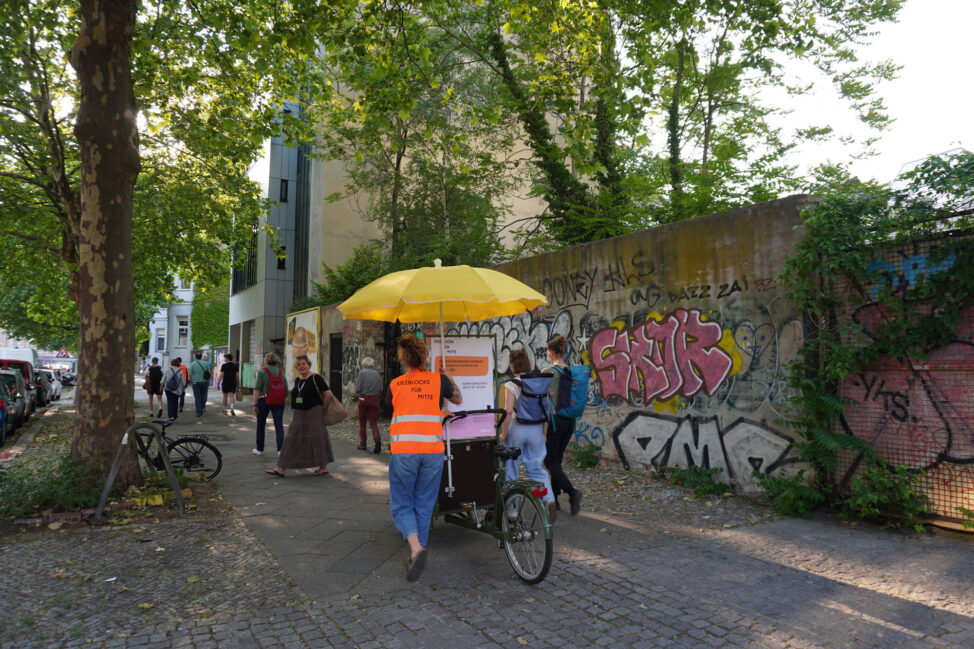During a total of 22 walks, the mobility planners presented ideas on how traffic could be reorganized in 25 Kiezes in Berlin’s Mitte district. The participation team talked to over 700 residents and interested parties about what measures they could and could not imagine for their neighborhoods. Questions about Kiezblocks were also answered during the walks.
Many thanks for the stimulating exchange and the many valuable tips to all those who took the time to attend!
We already reported on the Kiez walks at the Bergfest and shared impressions from 11 Kiezes . What was discussed on the walks through the remaining 14 Kieze is summarized in this article. The detailed documentation will be published once the participation is complete.
Gartenstraßenkiez
Around 30 people came to the walk at Gartenstraßenkiez. In addition to residents, representatives from the BVV and the House of Representatives also took part. After much discussion about Kiezblocks in general at the starting point, the participants shared their experiences of the measures already implemented in Kiez. One particular criticism was that the temporary summer street in Ackerstraße was not well thought out and was implemented without the involvement of local residents. In addition, the participants would like to see a holistic view of the Kieze, as through traffic is currently diverting into neighboring streets due to the measures in Gartenstrasse. During the rest of the walk, all residents agreed that measures are needed to calm and slow down traffic. There was intensive discussion about which ones would be most suitable. Some participants noted that the acceptance of bollards may be lower than that of other measures and suggested using one-way streets, narrowing lanes and turning lanes.
Auguststraßenkiez
Around 50 people took part in the Auguststraßenkiez neighborhood walk. In addition to residents, representatives of the BVV and the House of Representatives, several citizens’ initiatives and representatives of Changing Cities also took part. The ruling by the Higher Administrative Court on the Tucholskystraße modal filter had created a tense atmosphere between supporters and opponents. Despite general criticism of, for example, rows of bollards, the majority of participants spoke out in favor of traffic calming in Kiez through other measures such as one-way street regulations or swerving lanes. A major problem in Kiez is the back-up from the congested main roads. Some participants expressed concern about traffic shifting within the Kieze. Many participants wanted comprehensive planning that included the main roads.
Scheunenviertel and Rosa-Luxemburg-Platz
Two Kieze were on the agenda for this walk: Scheunenviertel and Kiez around Rosa-Luxemburg-Platz – both Kieze, where various traffic calming and traffic management measures have already been implemented. Around 35 people from the neighborhoods took part and provided numerous comments. It was generally noted that the current regulations are confusing due to the large number of signs and that cyclists in particular do not adhere to the rules. The situation around the northern exit of the subway station Rosa-Luxemburg-Platz, which is confusing for all road users, was discussed intensively, where participants felt that the implementation of a safe crossing or a central island is urgently needed. In Mulackstraße, which is a one-way street and can be used by cyclists in both directions, dangerous situations often arise. Many participants would like to see traffic slowed down there, for example by means of lane swings.
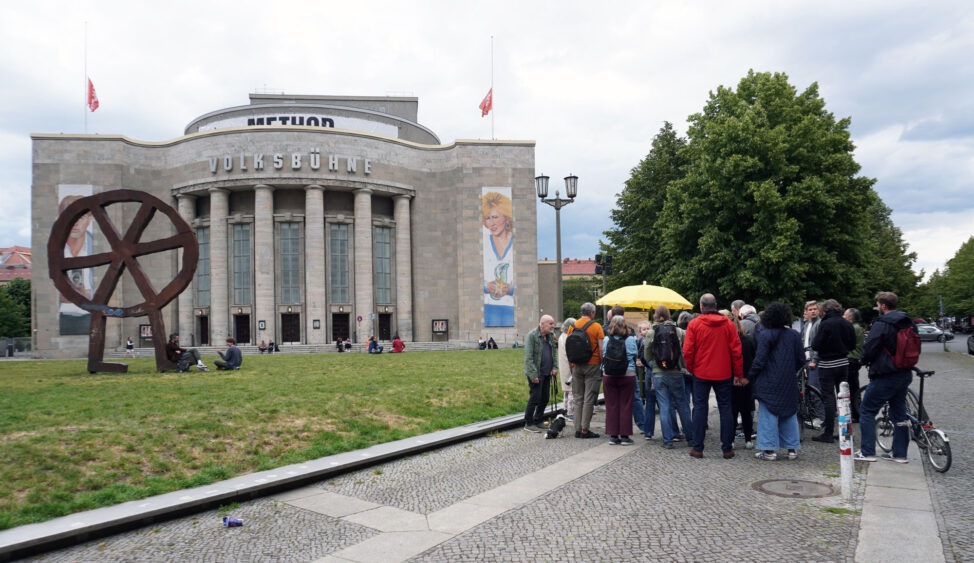
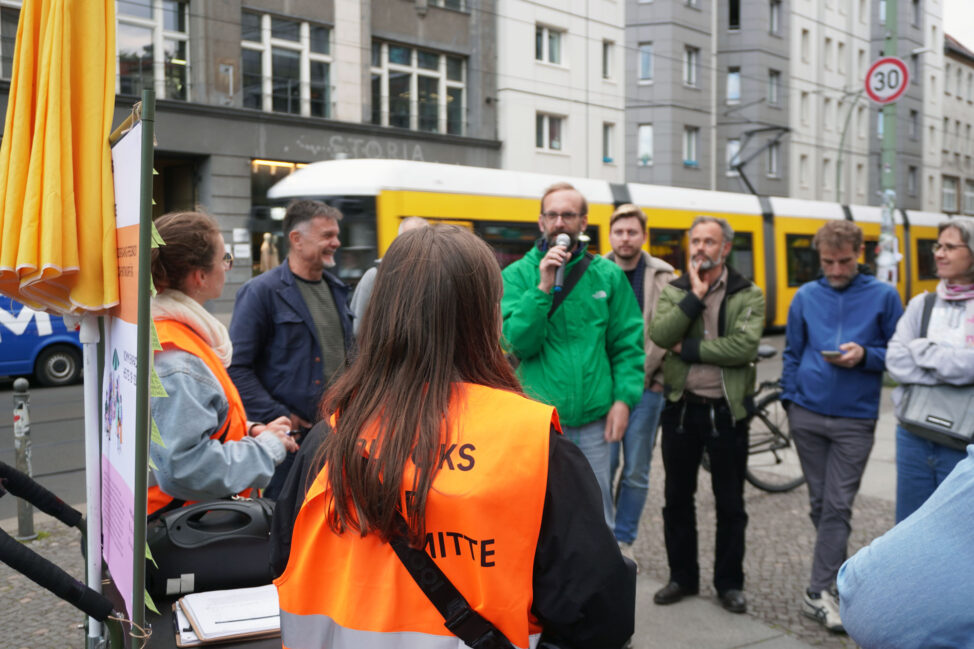
Dircksenstraße
We were out and about with a group of around 12 people at Kiez Dircksenstraße right next to Alexanderplatz. The participants told us that there are often dangerous situations for pedestrians and cyclists with cars that do not observe the speed limits. The traffic regulations at some junctions are also unclear and/or disregarded. Due to the large number of cyclists, pedestrians also sometimes do not feel safe and would like clearer rules and opportunities to travel safely.
Gendarmenmarkt and Krausenstraße
Around 25 people took part in the walk through the two Kieze Gendarmenmarkt and Krausenstraße. A representative from Changing Cities e.V. and IG Leipziger Straße were also present. The expansion of the square situation on Hausvogteiplatz was received differently. It is important to the residents that the square is upgraded to increase the quality of their stay. A major concern was to ensure safe crossings in front of daycare centers and schools and to strengthen the planned measures, for example by adding thresholds in addition to safe crossings. The desire for more bicycle stands was also expressed and specific locations suggested. Charlottenstraße with its intersections is perceived by residents as particularly busy and unsafe for cyclists and pedestrians – further measures to slow down motor vehicle traffic are desired here.
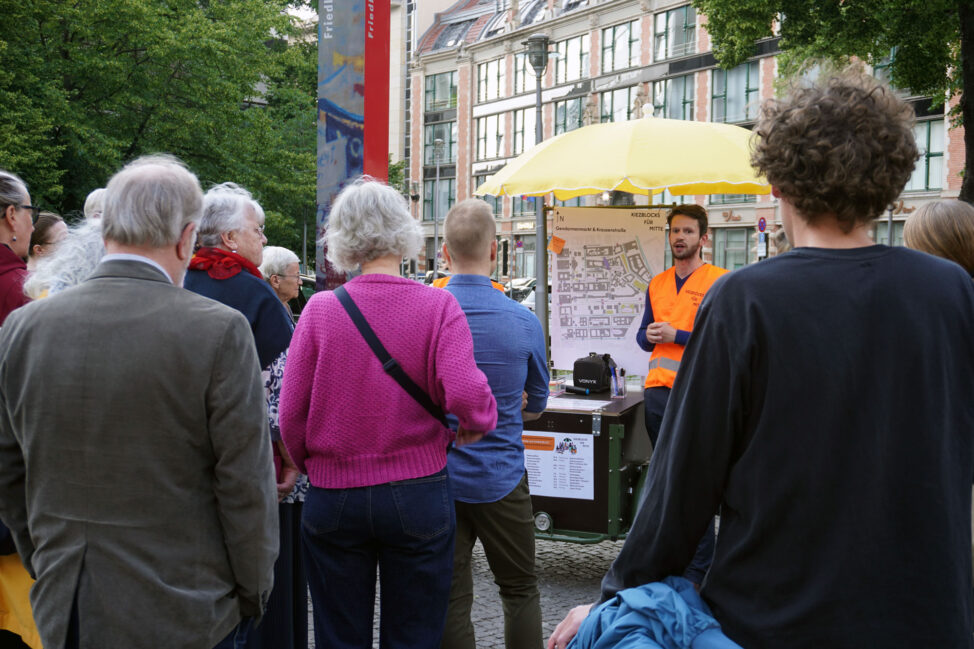
Flottwellkiez
We were out and about with our equipped cargo bike at Flottwellkiez with around 22 people. Participants from the neighborhood explained that there is a lot of through traffic when Potsdamer Straße is closed or blocked. In addition to some tips on how to drive through Kiez and where pedestrians and cyclists get in each other’s way, the idea of signposting Flottwellstraße as a cycle lane to provide a parallel route to Gleisdreieck Park was also put forward.
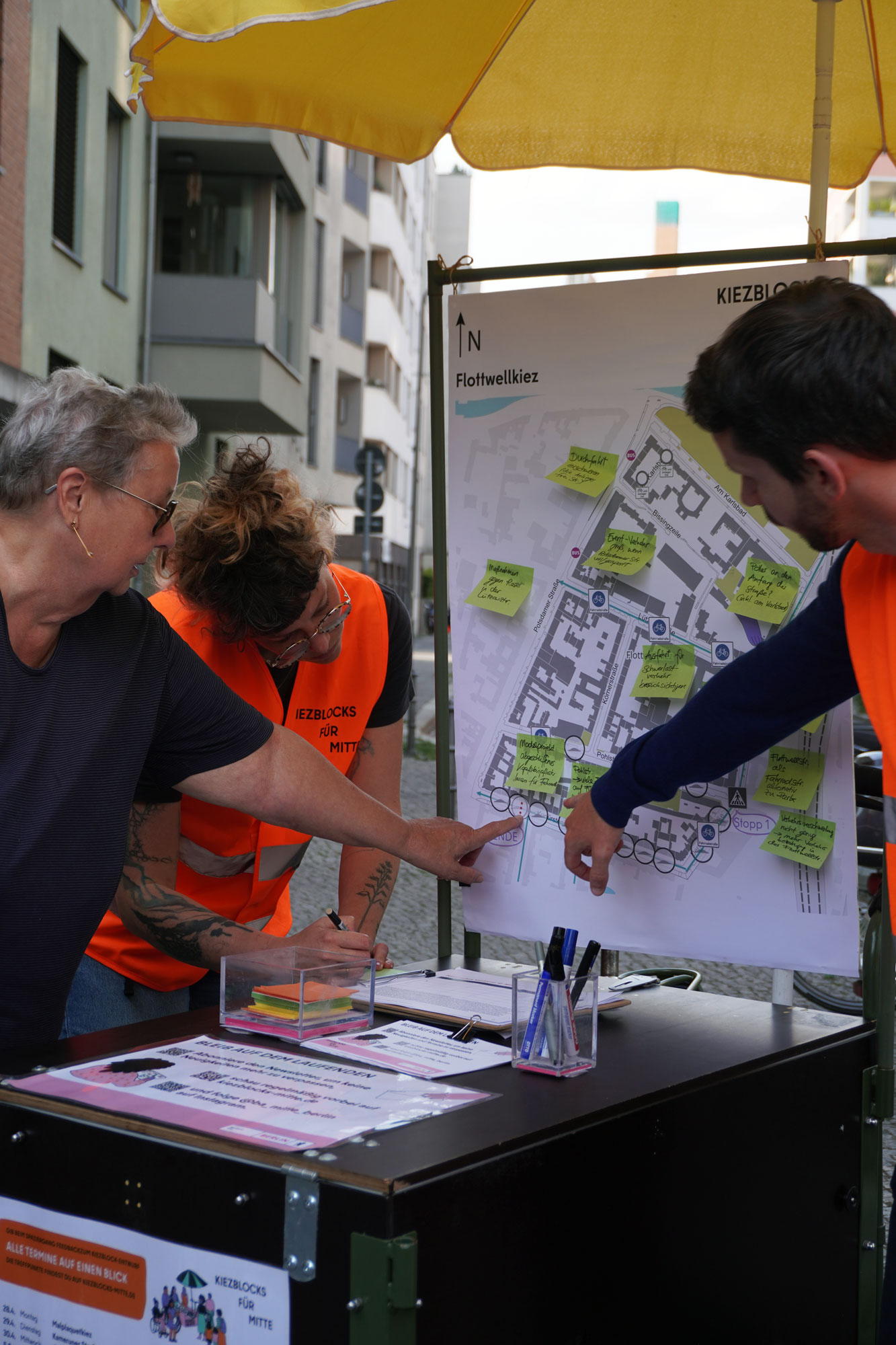
Beusselkiez North
In Beusselkiez Nord, motorized traffic is already slowed down by traffic-calmed areas and Moabit cushions in several streets. However, during the neighborhood walk, in which around 15 people took part, it became clear that many road users do not adhere to the applicable rules. At the Rostocker Straße/Wittstocker Straße junction in particular, there is wild parking and speeding is observed; some participants described dangerous situations, especially for cyclists, who therefore and also due to the cobblestones mostly avoid the sidewalks. Participants feared that the proposed measures in Berlichingenstraße would exacerbate the problem in these streets. They also wished for additional bicycle and e-scooter parking spaces and pointed out that bicycle corpses and bulky waste impair the accessibility of the sidewalks.
Moabit West and Ottopark
Around 60 people took part in the walk through the two Kieze Moabit West and Ottopark, despite the pouring rain. A major topic was the fact that regular disregard for speed limits leads to dangerous situations on the roads. Many intersections, such as the corner of Wiclefstraße and Waldstraße, were considered to be confusing and therefore dangerous, especially for children, due to cars parked in the intersection area and on sidewalks. Local people want safe crossings there, especially in front of the playgrounds and the schools, children’s and youth facilities. Cyclists often have to use the sidewalk throughout Kiez because the cobblestones are difficult to ride on and they do not feel safe due to the heavy vehicle traffic. The proposed traffic calming of Ottostrasse met with approval, but was also viewed critically in terms of delivery traffic, traffic congestion on Gotzkowskystrasse and the detours to be taken.
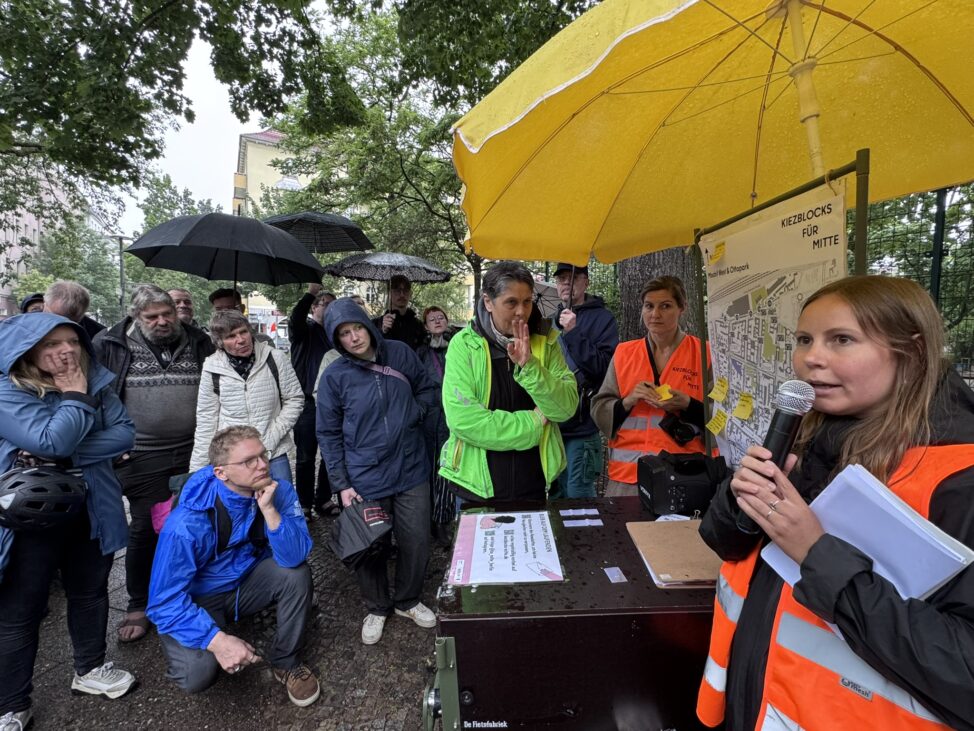
Stephankiez
Around 30 people attended the walk at Stephankiez. The draft was generally well received. As in previous walks, it was noted that road users do not adhere to speed limits or other signage (some parts of the Kieze are actually a traffic-calmed area). For this reason, measures were requested that would have a greater impact, such as lane swings. Another important topic was increasing the quality of life in places where people already spend time, such as Stephanplatz. A school zone could also be useful here. Unsealing, lighting and greening measures at the entrance to Pulitzbrücke were also welcomed. When considering Kiezblock, excessive detours for motor vehicle traffic should be avoided.
Wilsnacker Straße
Around 20 people took part in the neighborhood walk at Wilsnacker Straße, including residents and members of parliament from Moabit. In general, most participants saw a great need for traffic calming measures, especially at intersections that are difficult to see, such as Wilsnacker Straße/ Birkenstraße. Here it was criticized that although a safe intersection was implemented, safety only exists when important intersection areas are secured by structural measures. There is also a demand from local residents for more bicycle parking facilities and recreational areas in public spaces. Currently, the main problems in Kiez are that existing speed limits are not adhered to and there is illegal parking at intersections. The existing traffic calming measures, in particular Moabit cushions, were rated positively.
Lehrter Straße
Around 25 people took part in the walk through Kiez Lehrter Straße to discuss measures for their Kiez. The discussions focused in particular on Lehrter Straße, which, according to reports from residents, is used by many drivers as a shortcut as an alternative to Heidestraße. Due to the heavy through traffic and perceived speeding, Lehrter Straße has a barrier effect, especially for children. In addition to safe crossing options, such as making the current temporary traffic lights more permanent, participants also wanted measures to calm and slow down traffic. Among other things, paving between Platz der Nachbarschaft and Fritz-Schloß-Park and the creation of a residential street were discussed. As the Lehrter Straße is also used by BVG buses, there are special requirements, which were put forward by two BVG employees.
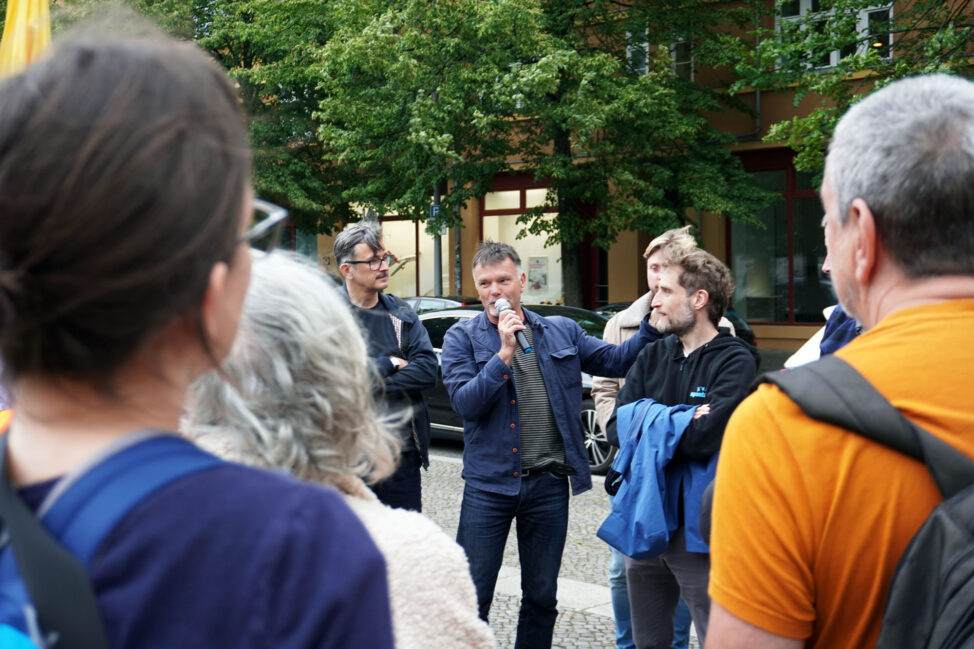
If you missed the walk through your Kiez, don’t worry: from today, you can also submit your comments on the Kiezblock draft for your neighborhood online. You can find out how to do this under Participate.
